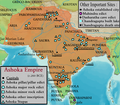File:Ashoka Empire.png

本预览的尺寸:688 × 600像素。 其他分辨率:275 × 240像素 | 551 × 480像素 | 881 × 768像素 | 1,060 × 924像素。
原始文件 (1,060 × 924像素,文件大小:1.22 MB,MIME类型:image/png)
文件历史
点击某个日期/时间查看对应时刻的文件。
| 日期/时间 | 缩略图 | 大小 | 用户 | 备注 | |
|---|---|---|---|---|---|
| 当前 | 2024年3月28日 (四) 07:38 |  | 1,060 × 924(1.22 MB) | Facttez999a2z | kamboja naming |
| 2024年2月16日 (五) 09:45 |  | 1,060 × 924(1.21 MB) | Facttez999a2z | minor improvements | |
| 2024年1月4日 (四) 11:33 |  | 1,060 × 924(1.2 MB) | Facttez999a2z | Uploaded own work with UploadWizard |
文件用途
以下页面使用本文件:
全域文件用途
以下其他wiki使用此文件:
- ast.wikipedia.org上的用途
- cs.wikipedia.org上的用途
- es.wikipedia.org上的用途
- hi.wikipedia.org上的用途
- ne.wikipedia.org上的用途
- si.wikipedia.org上的用途
- uk.wikipedia.org上的用途
- zh-classical.wikipedia.org上的用途
- zh-yue.wikipedia.org上的用途

